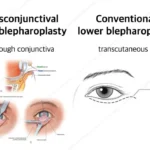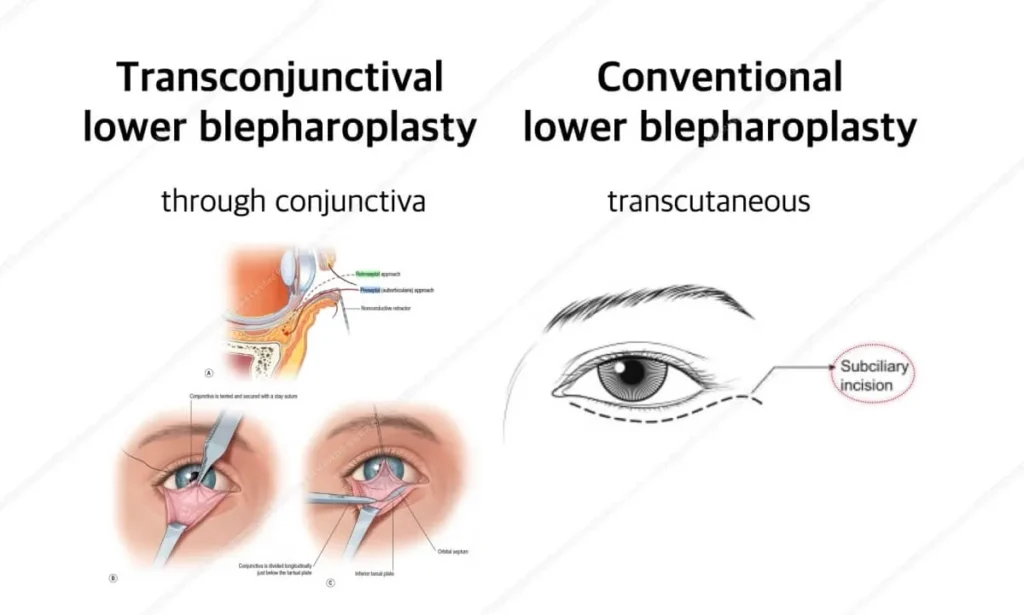Lower blepharoplasty, also known as a lower eyelid lift, is a surgical procedure that aims to rejuvenate aging features such as wrinkles, tear troughs, bags under the eyes, and dark circles. This article will provide an overview of the surgical process and history of lower eyelid surgery. You'll also see before and after photos to understand what can be improved through surgery and why fat grafting may be necessary in some cases.
FAQ
Q : What are surgical ways to improve bags under the eyes?

A : There are two procedures that can address the area under the eyes: traditional lower blepharoplasty, which involves cutting the skin, and transconjunctival lower blepharoplasty, which involves making an incision on the inside of the conjunctiva. The latter is primarily used to address puffiness caused by protruding fat and sunken areas, while lower eyelid surgery can also improve skin laxity.
Q : How long is the recovery time for lower lid surgery?
A : Because transconjunctival lower blepharoplasty does not require skin incision, they only require 3-4 days of rest before resuming normal activities. However, it is recommended to avoid strenuous activities during this time. Mild bruising may occur and can be concealed with makeup for the first 1-2 weeks.
Q : How long does the effect of lower blepharoplasty last?
A : The longevity of the rejuvenation effect of the surgery varies based on the individual patient's condition, such as the degree of under-eye hollowness and the size of the fat bag. In some cases, combining fat grafting with surgery can improve patient satisfaction and prolong the effect.
1. What is Lower Eyelid Surgery? : Understanding the Goals and Techniques
Lower blepharoplasty addresses under eyelid wrinkles and eye bags to restore a youthful appearance to the lower eyelid. The surgery can be divided into two categories based on the incision placement: transconjunctival (incision on the inner aspect of the eyelid skin) and transcutaneous (incision on the outside of the skin).

The main goal is typically to achieve three results:

- Reduce the size of the fat bags under the eyes (yellow),
- Improve the appearance of depressed tear troughs (green),
- Remove any lax skin and improve lower lid wrinkles.
The transcutaneous approach addresses all three goals, while the transconjunctival approach focuses on the first two. Later technique is typically recommended for patients in their mid-40s who have tight skin without noticeable wrinkles.
2. Incision Scar Visibility After Eyelid Bag Removal
To mask the scar, the incision for lower eyelid surgery is typically placed at the borderline between the eyelid and cheek. As a result, the scar is usually not noticeable. Please follow the before and after photos below to better understand what the scar will look like.
3. Evolution of Lower Eyelid Lift
1) Skin incision and Fat Excision (the 1950s to 1970s):
In the past, doctors primarily focused on removing fat bulges in the lower eyelid. (Blepharoplasty for herniated intraorbital fat. Anatomical basis for a new approach). This approach was widely used until the 1970s. Further surgical modifications had blossomed to tighten the muscle. (The orbicularis oculi muscle: Management in blepharoplasty).
2) Skin incision and Fat Repositioning (the 1980s to Present):
Dr. Loeb revolutionized lower eyelid surgery by advocating for the repositioning of fat rather than its removal. He believed that transferring the fat was more effective in improving aging features around the lid-cheek junction. (Fat pad sliding and fat grafting for leveling lid depressions).
This idea was further developed by Dr. Hamra, who proposed the "septal reset" method of moving the fat downward beyond the arcus marginalis. ." (The role of orbital fat preservation in facial aesthetic surgery: A new concept).

Ref: Dr. Hamra's Composite Rhytidectomy 1993
His idea spread worldwide, and today fat repositioning is the most common technique among Korean plastic surgeons. Recent studies have shown that fat decreases with age, so doctors believe that relocating fat instead of removing it is a more effective rejuvenation method.
3) Subconjunctival Fat Repositioning and Non-Invasive Techniques (the 2000s to Present):
In recent years, there has been a trend toward minimizing the post-operative recovery period. Therefore, fat repositioning though conjunctiva (the innermost layer of the eyelid) approach or using hyaluronic acid fillers became popular in addressing volume loss. Non-invasive techniques, like dermabrasion to treat lax skin have also been introduced.

Chin-Ho Wong's Extended Transconjunctival Lower Eyelid Blepharoplasty with Release of the Tear Trough Ligament and Fat Redistribution.
Treating eye bags through the conjunctiva and removing skin laxity from the outside can help preserve the orbital muscle, reducing the risk of ectropion. This minimal invasive approach has gained popularity due to its safety, quick recovery, and ease of use for less experienced surgeons.
4. Ideal Facial Rejuvenation: What to Look For
When it comes to cosmetic surgery, it's not just about medical importance but about meeting the needs and desires of consumers. For that reason, there is little room for error regarding side effects and complications. One of the most common causes of disappointment after a lower eyelid lift is an evaluation error during the consultation, leading to an incorrectly selected procedure.
To achieve an ideal result, the following criteria should be met:
1) No Side Effects
A flawless cosmetic surgery with no complications is a must.
2) Short Recovery
No matter how good the results are, no one wants a long and tedious recovery.
3) Natural Appearance
A harmonious and youthful appearance should be comprehensive and include all parts of the face.
4) Long-lasting Results
Surgical results should be long-lasting and not require frequent repetition.
5) Technical Ease
The ideal procedure should be easy for any doctor to achieve the best results.
While it can be challenging to satisfy all these criteria, many surgeons might be surprised that fat grafting is the secret key to achieve these ideal goals.
5. A Blueprint for Lower Eyelid Rejuvenation
The history of lower eyelid surgery can be seen as a logical evolution in managing orbital fat. Once thought of as something to be removed, now it is considered to be preserved. Due to each individual's varying aging process and facial structure, it's difficult to provide satisfaction with just one surgical method. This challenge is where fat grafting comes in, helping to overcome these limitations in contemporary orbital rejuvenation.
6. Bags Under Eyes Surgery Before and After: Lessons Learned from Case
In this case study, we will look at the differences in results between patients who underwent eye bag removal with or without fat grafting.
1) Satisfied results without fat graft
Satisfaction without fat grafting is more common when there are fewer aging stigmas. These cases are where the herniated fat pad is sufficient to fill the small depression of the lower lid. In such cases, only repositioning the fat can produce satisfactory results.



2) Less favorable results without fat graft
In some cases, patients may achieve better results if fat grafting is done together with lower lid surgery. This longing is often due to insufficient skeletal support or limited orbital fat to reposition and fill the depression.

The above photo shows the results of lower blepharoplasty. Even though her tear troughs have been softened, it is still visible. You might be noticed that her pre-op fat pad is not big enough to fill the whole depressed lower lid. This is why she shows remnant tear troughs.

A 55-year-old patient who had bags under eyes treatment showed improvement after one week, two months, and four months post-op. However, her medial cheek bones were too weak to support the soft tissue, leading to remnant depression. She might have achieved a better outcome if the fat graft had been done in conjunction with the procedure.

A 51-year-old patient who underwent lower blepharoplasty three months prior showed a lack of skeletal support on the left side of the face. The results would have been improved if fat grafting had been performed along with the procedure.

In the left photo, a 68-year-old patient has noticeable eye bags. Right photo shows seven weeks after lower eyelid lift. While the patient is satisfied, the hollow appearance under the eye was too pronounced to be fully corrected by the eyelid lift alone. The result could have been improved by adding a fat transfer to fill the hollow area.
3) Satisfied results with fat graft

A 60-year-old patient who underwent lower blepharoplasty ten years prior agreed to have simultaneous fat grafting and lower lid surgery due to severe depression and lack of soft tissue support. The results were well-maintained with the fat graft allowing large depressed areas to be filled.

Another patient in her early 40s with typical aging lower lid features had her mid-cheek area filled with fat harvested from her abdomen. In the pre-op photo, she had little orbital fat with a distinct tear trough, the elongated appearance of lower lid with mid-cheek volume loss. The fat graft along the lower lid and mid-cheek area, trimmed with a subconjunctival incision, resulted in a well-blended lid-cheek junction. The patient was pleased with the outcome.

A man in his mid-30s concerned about hyperpigmented lower lid had a successful transconjunctival fat repositioning and nano fat graft applied to soften the dark circles. The nano fat graft is an effective solution for patients with dark circles caused by a thin skin.

A 43-year-old patient with a largely pseudo-herniated fat bag caused by a tear trough underwent fat grafting. The excess lower lid skin was incised and trimmed, but not the muscle, resulting in improved results. It is somewhat careful to judge the surgical result due to short-term follow-up and heavy makeup. Still, from personal experience, the fat graft is beneficial for better results.
In conclusion, the above cases demonstrate that fat grafting can provide better results than blepharoplasty alone with less downtime.
7. Is Simultaneous Fat Graft Necessary in Every Lower Lid Rejuvenation?
This article aims not to assert that fat grafting is always necessary but to stress that in many cases, it is crucial in achieving satisfactory and long-lasting results, especially in cases where disappointment might occur without it. The choice of the most suitable method among the various procedures depends on the experience and expertise of the surgeon.
8. Conclusion
The field of medicine evolves in a series of the thesis, antithesis, and synthesis. What was once considered right may become wrong as medical science advances. By revisiting history, we can gain valuable insight into the development of surgical techniques. In this article, I have shared my perspective on rejuvenating the lower lids and provided a brief overview of the surgical evolution in a lower blepharoplasty. Aesthetics in surgery are subjective, and there is no one-size-fits-all solution. I hope these thoughts are helpful to readers.
